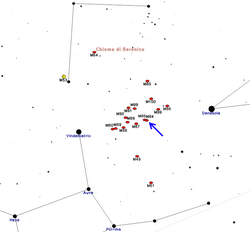Astronomy:Messier 84
| Messier 84 | |
|---|---|
 Galaxy Messier 84 in Virgo, imaged by the Hubble Space Telescope | |
| Observation data (J2000 epoch) | |
| Constellation | Virgo |
| Right ascension | 12h 25m 03.74333s[1] |
| Declination | +12° 53′ 13.1393″[1] |
| Redshift | 1,060±6 km/s[2] |
| Helio radial velocity | 999[3] km/s |
| Distance | 54.9 Mly (16.83 Mpc)[3] |
| Apparent magnitude (V) | 9.1[4] |
| Absolute magnitude (V) | −22.41±0.10[5] |
| Characteristics | |
| Type | E1[5] |
| Apparent size (V) | 6.5′ × 5.6′[2] |
| Half-light radius (apparent) | 72.5″±6″[5] |
| Other designations | |
| M84, NGC 4374, PGC 40455, UGC 7494, VCC 763[6] | |
Messier 84 or M84, also known as NGC 4374, is a giant elliptical or lenticular galaxy in the constellation Virgo. Charles Messier discovered the object in 1781[lower-alpha 1] in a systematic search for "nebulous objects" in the night sky.[7] It is the 84th object in the Messier Catalogue and in the heavily populated core of the Virgo Cluster of galaxies, part of the local supercluster.[8]
This galaxy has morphological classification E1, denoting it has flattening of about 10%. The extinction-corrected total luminosity in the visual band is about 7.64×1010 solar luminosity. The central mass-to-light ratio is 6.5, which, to a limit, steadily increases away from the core. The visible galaxy is surrounded by a massive dark matter halo.[5]
Radio observations and Hubble Space Telescope images of M84 have revealed two jets of matter shooting out from its center as well as a disk of rapidly rotating gas and stars indicating the presence of a 1.5 ×109 M☉[9] supermassive black hole. It also has a few young stars and star clusters, indicating star formation at a very low rate.[10] The number of globular clusters is 1,775±150, which is much lower than expected for an elliptical galaxy.[11]
Viewed from Earth its half-light radius, relative angular size of its 50% peak of lit zone of the sky, is 72.5″, thus just over an arcminute.
Two supernovae have been observed in M84: SN 1957B[12] and SN 1991bg.[13] Seen between these dates, it may have bore a third, SN 1980I – which may have been in either neighboring galaxy NGC 4387 or M86.[14] This high rate of supernovae is rare for elliptical galaxies, which may indicate there is a population of stars of intermediate age in M84.[11]
See also
References and footnotes
- ↑ 1.0 1.1 Lambert, S. B.; Gontier, A.-M. (January 2009). "On radio source selection to define a stable celestial frame". Astronomy and Astrophysics 493 (1): 317–323. doi:10.1051/0004-6361:200810582. Bibcode: 2009A&A...493..317L.
- ↑ 2.0 2.1 "NASA/IPAC Extragalactic Database". Results for NGC 4374. http://ned.ipac.caltech.edu/cgi-bin/objsearch?objname=m84&extend=no&hconst=73&omegam=0.27&omegav=0.73&corr_z=1&out_csys=Equatorial&out_equinox=J2000.0&obj_sort=RA+or+Longitude&of=pre_text&zv_breaker=30000.0&list_limit=5&img_stamp=YES.
- ↑ 3.0 3.1 Tully, R. Brent et al. (August 2016). "Cosmicflows-3". The Astronomical Journal 152 (2): 21. doi:10.3847/0004-6256/152/2/50. 50. Bibcode: 2016AJ....152...50T.
- ↑ "Messier 84". https://messier.seds.org/m/m084.html.
- ↑ 5.0 5.1 5.2 5.3 Napolitano, N. R. et al. (March 2011). "The PN.S Elliptical Galaxy Survey: a standard ΛCDM halo around NGC 4374?". Monthly Notices of the Royal Astronomical Society 411 (3): 2035–2053. doi:10.1111/j.1365-2966.2010.17833.x. Bibcode: 2011MNRAS.411.2035N.
- ↑ "M 84". SIMBAD. Centre de données astronomiques de Strasbourg. http://simbad.u-strasbg.fr/simbad/sim-basic?Ident=M+84.
- ↑ Jones, K. G. (1991). Messier's Nebulae and Star Clusters (2nd ed.). Cambridge: Cambridge University Press. ISBN 978-0-521-37079-0.
- ↑ Finoguenov, A.; Jones, C. (2002). "Chandra Observation of Low-Mass X-Ray Binaries in the Elliptical Galaxy M84". Astrophysical Journal 574 (2): 754–761. doi:10.1086/340997. Bibcode: 2002ApJ...574..754F.
- ↑ Bower, G.A. et al. (1998). "Kinematics of the Nuclear Ionized Gas in the Radio Galaxy M84 (NGC 4374)". Astrophysical Journal 492 (1): 111–114. doi:10.1086/311109. Bibcode: 1998ApJ...492L.111B.
- ↑ Ford, Alyson; Bregman, J. N. (2012). "Detection of Ongoing, Low-Level Star Formation in Nearby Ellipticals". American Astronomical Society 219: 102.03. Bibcode: 2012AAS...21910203F.
- ↑ 11.0 11.1 Gómez, M.; Richtler, T. (February 2004). "The globular cluster system of NGC 4374". Astronomy and Astrophysics 415 (2): 499–508. doi:10.1051/0004-6361:20034610. Bibcode: 2004A&A...415..499G.
- ↑ Götz, W. (1958). "Supernova in NGC 4374 (= M 84)". Astronomische Nachrichten 284 (3): 141–142. doi:10.1002/asna.19572840308. Bibcode: 1958AN....284..141G.
- ↑ Kosai, H. et al. (1958). "Supernova 1991bg in NGC 4374". IAU Circular 5400: 1. Bibcode: 1991IAUC.5400....1K.
- ↑ Smith, H. A. (1981). "The spectrum of the intergalactic supernova 1980I". Astronomical Journal 86: 998–1002. doi:10.1086/112975. Bibcode: 1981AJ.....86..998S.
- ↑ on 18 March
External links
- StarDate: M84 Fact Sheet
- SEDS Lenticular Galaxy M84
- Messier 84 on WikiSky: DSS2, SDSS, GALEX, IRAS, Hydrogen α, X-Ray, Astrophoto, Sky Map, Articles and images
Coordinates: ![]() 12h 25m 03.7s, +12° 53′ 13″
12h 25m 03.7s, +12° 53′ 13″
 |



